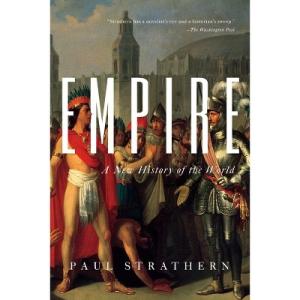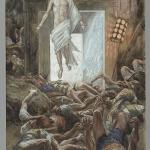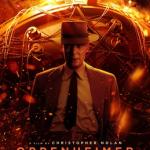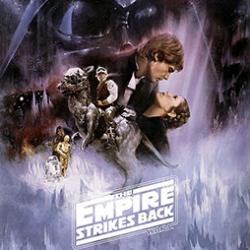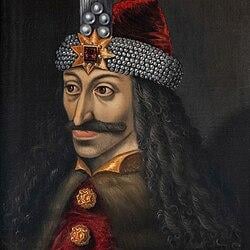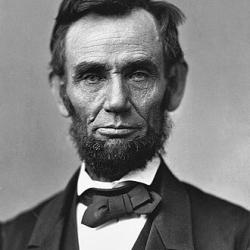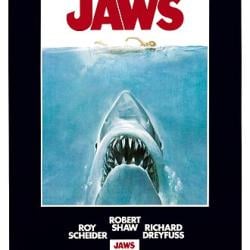Last Time on HOARATS
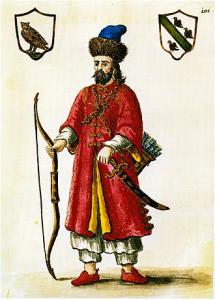
Giovanni Grevembroch– Marco Polo
15th Century
15th century: c. 1400 – c. 1500 – Oxford Reference
Popes 204 – 214 reigned on the throne of St. Peter.
0 Saint Popes
0 Blessed Pope
11 Non – Sainted Popes
6 Anti – Popes
1 Interregnum
These next two centuries featured the Explorers, Reformers & the inventors, royalty, writers and artists of the Renaissance that changed the world. Some of the characters of the Renaissance include…
Leonardo da Vinci, Niccolò Machiavelli, and Cesare Borgia: a unique constellation—each, in his own way, emblematic of a distinct aspect of humanity.
Borgia has become a byword for monstrous deeds—his very name summoning up images of betrayal, murder, and depravity.
Leonardo, on the other hand, has become a supreme exemplar of higher human aspiration.
Machiavelli, by comparison, was very much a normal man: someone who liked joking and drinking with his friends, who enjoyed sexual peccadilloes, who had ambition and strove to ascend the slippery pole of civic life. He fibbed, negotiated, spied, and wrote reports for his political masters—here was the ultimate civil servant.
Leonardo, Machiavelli, and Borgia: as the lives of these disparate individuals unfold, we see how each illustrates an aspect of the Renaissance—its art, its philosophy, and its wars. Borgia was the actor strutting the boards, Machiavelli plotted the devious script, while Leonardo painted the set and designed the ingenious mechanical devices that shifted the scenery.
The tempestuous history of Italy during the Renaissance produced men of genius as well as ogres, many of the greatest works of art known to humanity, and ambitious schemes the like of which had never been seen before. Dark and horrendous events frequently underlay the glories of the Renaissance, and both glory and horror ran through the lives of Leonardo, Machiavelli, and Borgia.
Paul Strathern, The Artist, the Philosopher, and the Warrior: The Intersecting Lives of Da Vinci, Machiavelli, and Borgia and the World They Shaped (2009) Random House Publishing Group
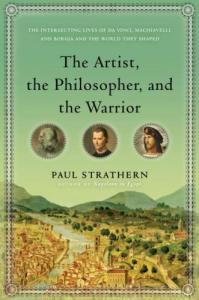
The Load of Unicorn (1959) is a children’s historical novel written and illustrated by Cynthia Harnett. It is set in London in 15th century, and concerns the adventures of an apprentice of William Caxton, the printer. The title refers to a load of paper with a unicorn watermark, ordered by Caxton from Flanders but never delivered.
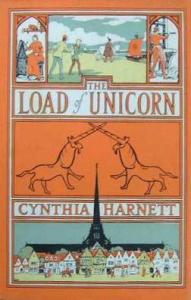
1405: At the turn of the fifteenth century, China was by some degree the most advanced civilisation on earth. This was the land, tales of whose wonders Marco Polo had earlier brought back to Europe. In 1405, Zhu Di, third emperor of the Ming Dynasty, ordered Admiral Zheng He to set sail from China with his fleet to explore ‘the oceans of the world’.The f leet he commanded was of impressive proportions. It contained over three hundred large ocean-going, wooden-sailed junks manned by more than 28,000 men. The admiral’s treasure ship, a replica of which can be seen in Nanjing today, was 450 feet long. No comparable fleet would put to sea for over four centuries, until the First World War. Zheng
He and his fleet undertook six voyages between 1405 and 1424, during the course of which he travelled from Vietnam to Indonesia, from Burma, India and Ceylon to the Persian Gulf and up the Red Sea to Jeddah, then around the Horn of Africa down as far south as Kenya. Precise records of these six voyages are no longer extant, but it seems likely that in the course of his travels, Zheng He must have covered a distance equivalent to circumnavigating the globe twice over. Amongst the many wonders that he transported back to China was a giraffe from Somalia. Its arrival in China caused a sensation, confirming the existence of the legendary Chinese qilin, which in the sixth century BC had foretold the arrival of ‘a king without a throne’: later taken to be the philosopher Confucius, whose ideas would guide China through two millennia.
–Paul Strathern, Empire: A New History of the World (2020) Pegasus Books.
March 25, 1409 – The Council of Pisa opens. On June 5 it deposes Pope # 205 Non – Saint Gregory XII 30 November 30, 1406 – July 4, 1415 -8 years, 216 days) and Antipope Benedict XIII, and on June 26 crowns Petros Philargos as Pope Alexander V; he is subsequently regarded as an antipope.
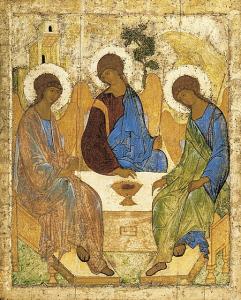
c. 1410–1420: Andrei Rublev paints his Trinity icon for the Trinity Lavra of St. Sergius (now in Tretyakov Gallery, Moscow).
1411–1413: Renaissance Artist Donatello’s Saint Mark is a marble statue that stands approximately seven feet and nine inches high and is displayed in the museum of the Orsanmichele church, Florence.
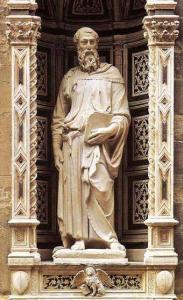
1414–1418: Catholic Ecumenical Council # 16 Council of Constance.
COC resolved the Great Western Schism and condemned John Hus.
By the early fifteenth century, banking had become an essential arm of the papal executive. Unlike any other European power of this period, most of its revenues were earned abroad, coming largely in the form of remittances from the vast number of sees throughout Europe. These sees extended to the very limits of the Western world – as far as Iceland and even Greenland (whose bishop paid in sealskins and whalebones, which were converted into cash in Bruges). Another form of income was the selling of holy relics, which often fetched an enormous price, as they had the power to transform an entire economy, turning the region that possessed them into a centre of pilgrimage. Even more lucrative was the trade in indulgences, which offered the purchaser the pope’s pardon for his sins, the price increasing dependent upon the magnitude of the sin involved. Another constant source of revenue was the selling of appointments to holy office, which involved offices from the lowest rank up to and including that of cardinal.
Paul Strathern, The Medici (Italian Histories) (2016) Pegasus Books.
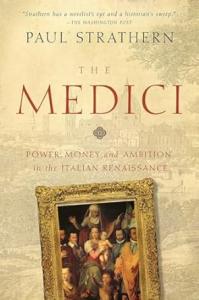
1415: Explorer Henry the Navigator leads the conquest of Ceuta from the Moors marking the beginning of the Portuguese Empire.
1420: Construction of the Chinese Forbidden City is completed in Beijing.
1427: Catholic Writer Thomas à Kempis’s Imitation of Christ is written.
Be not angry that you cannot make others as you wish them to be, since you cannot make yourself as you wish to be. Book I, ch. 16.
The Street of Booksellers, Via dei Librai, ran through the heart of Florence, midway between the town hall to the south and the cathedral to the north. In the 1430s the street was home to an assortment of tailors and cloth merchants, as well as a barrel maker, a barber, a butcher, a baker, a cheesemonger, several notaries, a manuscript illuminator, two painters who shared a workshop, and a pianellaio—a maker of slippers. It took its name, however, from the shops of the many booksellers and stationers, known as cartolai, scattered along its narrow stretch. Cartolai were at the very center of Florence’s manuscript trade, serving as booksellers, binders, stationers, illustrators, and publishers. An enterprising cartolaio might deal with everyone from scribes and miniaturists to parchment makers and goldbeaters, and sometimes even with authors themselves.
Ross King, The Bookseller of Florence: The Story of the Manuscripts That Illuminated the Renaissance (2021) Grove Atlantic
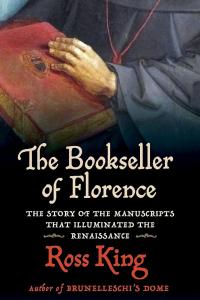
1431: January 9 – May 29-Trial of St. Joan of Arc.
It is said that Joan of Arc traveled through time to 1988.
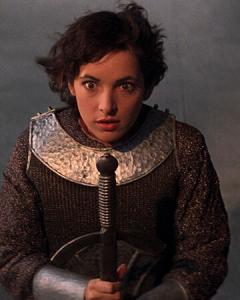
1431–1445: Catholic Ecumenical Council # 17 Council of Basel, Ferrara and Florence
This Council addressed church reform and reunion with the Eastern Churches but split into two parties. The fathers remaining at Basel became the apogee of conciliarism. The fathers at Florence achieved union with various Eastern Churches and temporarily with the Eastern Orthodox Church.
1436: Francisco Jiménez de Cisneros (1436 –November 8, 1517) is born in Spain, later to become a cardinal and advisor to Queen Isabella of Castille.
1436 – Florence Cathedral formally the Cathedral of Saint Mary of the Flower is the cathedral of Florence, Italy. It was begun in 1296 in the Gothic style to a design of Arnolfo di Cambio and was structurally completed by 1436, with the dome engineered by Filippo Brunelleschi (1377 – April 15, 1446).
The new cathedral of Santa Maria del Fiore was intended to be one of the largest in Christendom. Entire forests had been requisitioned to provide timber for it, and huge slabs of marble were being transported along the Arno on flotillas of boats. From the outset its construction had as much to do with civic pride as religious faith: the cathedral was to be built, the Commune of Florence had stipulated, with the greatest lavishness and magnificence possible, and once completed it was to be “a more beautiful and honourable temple than any in any other part of Tuscany.” But it was clear that the builders faced major obstacles, and the closer the cathedral came to completion, the more difficult their task would become.
Ross King, Brunelleschi’s Dome: How a Renaissance Genius Reinvented Architecture (2013). Bloomsbury Publishing
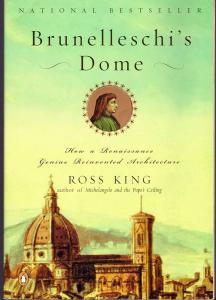
1438: Pachacuti founds the Inca Empire.
1439
The printing press is invented in Germany by Inventor Johannes Gutenberg. This invention help change and expand the world by producing more books for the populace to read. The Gutenberg Bible was the first book published.
Endymion Spring (2006) is a children’s fantasy novel by English Canadian author Matthew Skelton. The two story lines are about 600 years apart with one story taking place at the epoch of the printing press in 1453, and the other taking place in the late 20th or early 21st century.
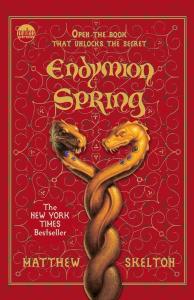
“What gunpowder did for war, the printing press has done for the mind.” – Wendell Phillips
Based on earlier Asian principles, Johannes Gutenberg’s movable type printing press propelled an industry that led to the education of the West and ultimately removed the tight grip of the Vatican from daily European life. Within less than a century of Gutenberg’s device appearing on the scene, printing presses had churned out tens of millions of copies of books of all types, and as more people became educated, lower classes became wealthier while revolutionary principles spread across borders like wildfire. In addition to ushering in the Renaissance, the printing press also made the Reformation possible, and just as gunpowder was revolutionizing medieval warfare, the printing press led to battles over ideas and the rise of nationalism. For better and worse, after Gutenberg’s printing press became available, the world would never be the same.
Charles River Editors The Printing Press: The History and Legacy of the Medieval Invention that Revolutionized Europe (2022).
1440- 69: Under Moctezuma I, the Aztecs become the dominant power in Mesoamerica.
1441: Portuguese navigators cruise West Africa and reestablish the European slave trade with a shipment of African slaves sent directly from Africa to Portugal.
Any commercial undertaking involving the carriage of millions of people, stretching over several hundred years, involving every maritime European nation, every Atlantic-facing African people (and some others), and every country of the Americas, is a planet of its own, always with room for new observations, reflections, evidence, and judgments. The slave trade was, of course, an iniquity. All the same, its study can offer something for almost everyone.
If one is interested in international morality, one can ask how it was that, in the seventeenth century, several Northern European countries hesitated so little before abetting a revival on a large scale of an institution which had nearly been abandoned in the region by the year 1100.
If church history is one’s speciality, one can wonder why the condemnations of Pope Pius II and three other popes were ignored in Catholic countries, and how Jesuits managed to be as deeply implicated as anyone. It might be interesting, too, to explore the precise terms in which Pope Pius condemned the traffic in slaves, and perhaps speculate why Catholic philanthropists of the sixteenth century, such as Bartolomé de Las Casas, did not at first extend the generous sympathies which they so warmly offered to American Indians to the black Africans.
Hugh Thomas The Slave Trade: The Story of the Atlantic Slave Trade: 1440-1870 (2013) Simon & Schuster
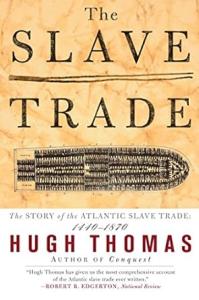
1442: Historian Leonardo Bruni (c. 1370 – March 9, 1444) defines Middle Ages and Modern times. He has been called the first modern historian. He was the earliest person to write using the three-period view of history: Antiquity, Middle Ages, and Modern. The dates Bruni used to define the periods are not exactly what modern historians use today, but he laid the conceptual groundwork for a tripartite division of history.
1447: St. Catherine of Genoa (1447 – September 15,1510) mystic and patron of the poor, is born in Italy.
1452: Girolamo Savonarola (September 21, 1452 – May 23, 1498) a popular Dominican preacher, is born in Italy.
1452:Renascence Inventor and Artist Leonardo da Vinci (April 15, 1452 – 2 May 2, 1519) is born.
1453: The Ottomans ended the Byzantine Empire with the conquest of Constantinople in by Mehmed the Conqueror
1455–1485: Wars of the Roses – English civil war between the House of York and the House of Lancaster.
The Black Arrow: A Tale of the Two Roses is an 1888 novel by Robert Louis Stevenson. The Black Arrow tells the story of Richard (Dick) Shelton during the Wars of the Roses: how he becomes a knight, rescues his lady Joanna Sedley, and obtains justice for the murder of his father, Sir Harry Shelton.
Non- Saint Pope # 209 Callixtus III (April 8, 1455 – 6 August 6, 1458) (3 years, 120 days) The first Spanish (Valencian) pope. Ordered the Feast of the Transfiguration to be celebrated on August 6. Ordered the retrial of Joan of Arc, in which she was vindicated. Appointed two nephews as cardinals, one of whom became Pope # 214 Alexander VI.
He is considered one of the most controversial of the Renaissance popes, partly because he acknowledged fathering several children by his mistresses. As a result, his Italianized Valencian surname, Borgia, became a byword for libertinism and nepotism, which are traditionally considered as characterizing his pontificate.
THE BORJA FAMILY (AS they were known in Spain) originated from the remote hill town of Borja, some 150 miles west of Barcelona in the Kingdom of Aragon. This occupied the large wedge of eastern Spain south of the Pyrenees, including Catalonia. As we have seen, the first Borgia pope was Callixtus III, of whom it has been said: ‘The election to the papacy of Alonso de Borja as Callixtus III was little more than an accident, yet without it, there might never have been such a phenomenon as the Borgia Age.’
-Paul Strathern, The Borgias: Power and Fortune (Italian Histories) (2019) Pegasus Books
1456: Joan of Arc is posthumously acquitted of heresy by the Catholic Church, redeeming her status as the heroine of France.
June 29, 1456 – Pope # 209 non-saint Callixtus III 8 April 8, 1455 – August 6, 1458 – 3 years, 120 days) ordered the bells of every European church to be rung every day at noon, as a call for believers to pray for the defenders of the city. The practice of the noon bell is traditionally attributed to the international commemoration of the victory at Belgrade and to the order of Pope Callixtus III, since in many countries (like England and the Spanish Kingdoms) news of the victory arrived before the order, and the ringing of the church bells at noon was thus transformed into a commemoration of the victory. The Pope did not withdraw the order, and Catholic and the older Protestant churches still ring the noon bell to this day. To commemorate this victory, Callixtus III ordered the Feast of the Transfiguration to be held annually on 6 August.
1466: Humanist writer Desiderius Erasmus (October 28, 1466 – 12 July 12. 1536) is born in Rotterdam.
1469: Writer Niccolò Machiavelli (May 3, 1469 – June 21, 1527), author of The Prince, is born in Italy.
October 19, 1469 – Queen Isabella I (April 22, 1451 – November 26, 1504) marries her second cousin King Ferdinand II (March 10, 1452 – January 23, 1516). Because they were second cousins, they stood within the prohibited degrees of consanguinity and the marriage would not be legal unless a dispensation from the Pope was obtained. Pope # 210 Non-Saint Pius II (August 19, 1458 – 15 August 15, 1464 – 5 years, 362 days) issued a supposed papal bull authorizing Ferdinand to marry within the third degree of consanguinity, making their marriage legal. Afraid of opposition, Isabella eloped from the court of Henry with the excuse of visiting her brother Alfonso’s tomb in Ávila. Ferdinand, on the other hand, crossed Castile in secret disguised as a servant.
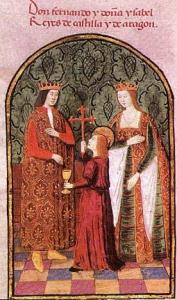
1473: Scientist Nicolaus Copernicus (February 19, 1473 – May 24, 1543) is born.
1478: The Tribunal of the Holy Office of the Inquisition commonly known as the Spanish Inquisition was established in by the Catholic Monarchs, King Ferdinand II of Aragon and Queen Isabella I of Castile.
1482–1520:Painter Raphael (March 28 or April 6, 1483 – April 6, 1520) is born.
1482:
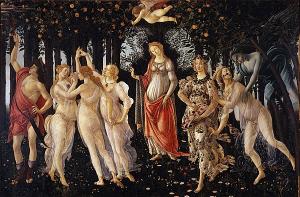
Sandro Botticelli, The Birth of Venus, 1486, Uffizi, Florence
1483: Reformer Martin Luther (November 10, 1483 – February 18, 1546) famous German Protestant reformer, is born in Germany.
1483: The Golden Legend was re-translated and printed by William Caxton under the name The Golden Legende, and subsequently reprinted many times due to the demand.
Thus endeth the legend named in Latin Legenda Aurea, that is to say in English, the Golden Legend. For like as gold passeth in value all other metals, so this legend exceedeth all other books, wherein be contained all the high and great feasts of our Lord, the feasts of our Blessed Lady, the lives, passions, and miracles of many other saints, and other histories and acts, as all along here afore is made mention. Which work I hare accomplished at the commandment and request of the noble and puissant earl, and my special good lord, William, earl of Arundel, and have finished it at Westminster the twentieth day of November, the year of our Lord fourteen hundred and eighty-three, and the first year of the reign of King Richard III. By me, William Caxton.
1484: William Caxton, the first printer of books in English, prints his translation of Aesop’s Fables in London.
1484: Reformer Huldrych Zwingli (January 1, 1484 – October 11, 1531) leader of the Reform church in Zurich, is born in Switzerland.
1485-The first complete edition of Dr. St. Thomas Aquinas’s Summa Theologica is printed at Basle.
- The image of God always abides in the soul, whether this image be obsolete and clouded over as to amount to almost nothing; or whether it be obscured or disfigured, as is the case with sinners; or whether it be clear and beautiful as is the case with the just. I, q. 93, art. 8, ad 3
- To love is to will the good of the other.-I-II, q. 26, art. 4
- Man cannot live without joy. That is why one deprived of spiritual joys goes over to carnal pleasures.-II–II, q. 35, art. 4, ad. 2
- Just as it is better to illuminate than merely to shine, so to pass on what one has contemplated is better than merely to contemplate.-II–II, q. 188, art. 6
1485 to 1603: The House of Tudor was a royal house of largely Welsh and English origin that held the English throne from.
1486: Reformer Johann Eck (November 13, 1486 – February 10, 1543) a German theological rival to Luther, is born.
1486: Reformer Andreas Karlstadt (1486 – December 24, 1541), is born in Wittenberg.
1486:
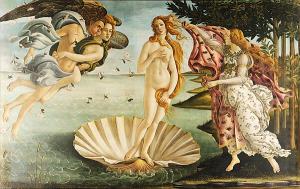
Sandro Botticelli, The Birth of Venus, 1486, Uffizi, Florence
1490: Our Lady of the Watch-An Italian peasant named Benedetto Pareto reported seeing an apparition of Mary on top of Monte Figogna (near Genoa, Italy) on August 29, 1490. Pareto said that the Virgin Mary appeared to him and asked him to build a church atop the mountain. Pareto at first refused, saying that he was just a poor man, but he eventually built a small wooden structure, which in time gathered many pilgrims and is now contained within the Shrine of Our Lady of the Watch. (The apparition is so-named because Monte Figogna used to be a watch-point for the strategic observation of armies and ships.)
1491: St. Ignatius of Loyola (October 1491– 31 July 31, 1556) is born in Spain.
1492: Royalty Ferdinand and Isabella sign the Alhambra Decree, expelling all Jews from Spain unless they convert to Catholicism; 40,000–200,000 leave.
1492: In Florence, the Renaissance was approaching its zenith, with the city’s leading artists recognised as the most advanced in Italy, producing works that continue to this day to be regarded as pinnacles of human achievement. By 1492, Botticelli had already painted his masterpieces Spring (Primavera) and The Birth of Venus, and had worked on the Sistine Chapel in Rome. Leonardo da Vinci had left for Milan, where he had already sketched detailed plans for a manned flying machine and would soon begin painting The Last Supper. Meanwhile the precocious seventeen-year-old Michelangelo had begun sculpting his first masterwork, The Battle of the Centaurs, which had been commissioned by Lorenzo the Magnificent himself.
Paul Strathern, Death in Florence (Italian Histories) (2015) Pegasus Books
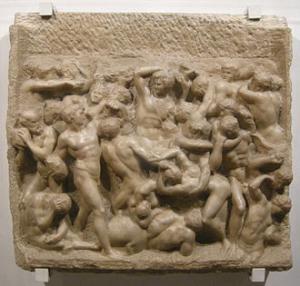
1492
Explorer Christopher Columbus (between August 25, and October 31, 1451 –May 20, 1506) sails to the “New World” under the direction of the Spanish crown. On October 12, 1492, the Italian adventurer sailing into the unknown landed in the Bahamas, incident became known as the “discovery” of America (or, “The New World” if you prefer). This is the 2nd big event that helped pave the way for big changes for Europe and every civilization on the planet.
Historians have long argued that Columbus merely rediscovered the Americas, that the Vikings, the Celts, and American Indians arrived in the “New World” long before his cautious landfall. But Columbus’s voyages to the New World differed from all the earlier events in the scope of its human drama and ecological impact. Before him, the Old World and the New remained separate and distinct continents, ecosystems, and societies; ever since, their fates have been bound together, for better or worse.
To the end of his days, Columbus remained convinced that he sailed for, and eventually arrived at, the outskirts of Asia. His unshakeable Chinese delusion motivated his entire subsequent career in exploration. No comparable figure in the age of discovery was so mistaken as to his whereabouts. Had Columbus been the one to name his discovery, he might well have called it “Asia” rather than “America.”
– Laurence Bergreen, Columbus: The Four Voyages, 1492-1504 (2011) Penguin Publishing Group
March 15, 1493— Christopher Columbus made his triumphant return from his first voyage to the New World, a momentous occasion in human history and especially noteworthy for the Spanish Crown that he sailed for.
1493: Leonardo da Vinci creates the first known design for a helicopter.
1494: Artist Qiu Ying (1494 – 1552) is born. He was a Chinese painter of the Ming dynasty who specialised in the gongbi brush technique.
March 5, 1496:- In the wake of the tremendous news about the voyage of Christopher Columbus to the New World King Henry VII of England granted “letters patent” to John Cabot, an Italian sailor and adventurer, along with his sons, to explore the world on behalf of the English Crown.
June 24, 1497: –Explorer John Cabot ( c. 1450 – c. 1500) lands in North America (near present day Bonavista, Newfoundland).
1498: Reformer Felix Manz (c. 1498 – January 5, 1527) Anabaptist leader and martyr of the Radical Reformation, is born in Zurich.
c. 1495–1498: The Last Supper by the Italian High Renaissance artist Leonardo da Vinci, is painted.
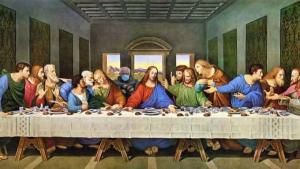
Lodovico Sforza, [was] the ruler of Milan. Lodovico had been an enthusiastic patron of the arts ever since, at the age of thirteen, he commissioned a portrait of his favorite horse. Under his rule, intellectual and artistic luminaries flocked to Milan: poets, painters, musicians, and architects, as well as scholars of Greek, Latin, and Hebrew. The universities in Milan and neighboring Pavia were revived. Law and medicine flourished. New buildings were commissioned; elegant cupolas bloomed on the skyline. With his own hands Lodovico laid the first stone of the beautiful church of Santa Maria dei Miracoli presso San Celso.
Among the brilliant courtiers in Lodovico Sforza’s Milan was an artist celebrated above all others. “Rejoice, Milan,” wrote a poet in 1493, “that inside your walls are men with excellent honours, such as Vinci, whose skills in both drawing and painting are unrivalled by masters both ancient and modern.”9 This virtuoso was Leonardo da Vinci who, at forty-two, was exactly the same age as Lodovico.
Ross King, Leonardo and the Last Supper (2012)
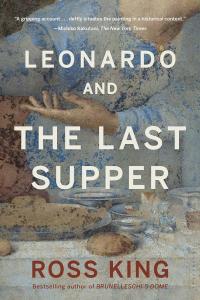
1497–1499: Vasco da Gama, 1st Count of Vidigueira (c. 1460s – December 24,1524), was a Portuguese explorer and the first European to reach India by sea. His initial voyage to India by way of Cape of Good Hope was the first to link Europe and Asia by an ocean route, connecting the Atlantic and the Indian oceans. This is widely considered a milestone in world history, as it marked the beginning of a sea-based phase of global multiculturalism.
1499: Michelangelo‘s Pietà in St. Peter’s Basilica is made in Rome.
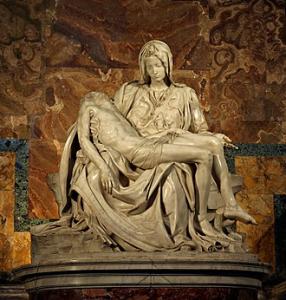
Next Time on
HOARATS
Renascence, Reformation, Trent & Guadalupe Change 16th Cent APRIL 4, 2024
To Understand
What I love and How I Write About History
Hit the Link Above.
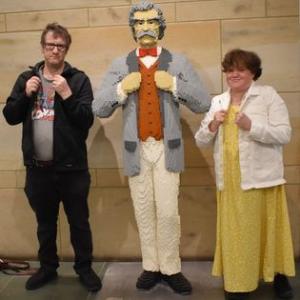
To understand about this particular series I’m writing about, please read
The Catholic Bard’s Guide To History Introduction
And to view a historical article click on


